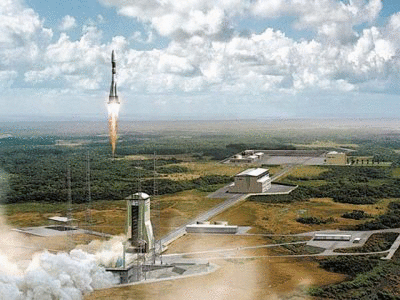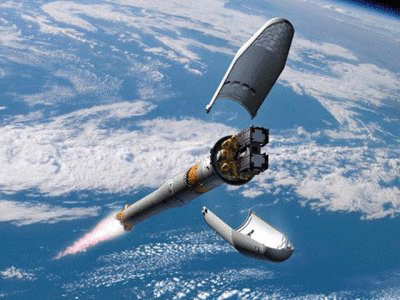The launch of "Vega" from the South American spaceport "Kourou" puzzled Russian experts
 RIA "News“, Referring to the head of the European Space Agency’s representative office in the Russian Federation, Rene Pischel, announced the launch of the latest European design - the Vega carrier rocket, belonging to a light class with scientific satellites. The first launch took place from the Kourou Cosmodrome, located in French Guiana.
RIA "News“, Referring to the head of the European Space Agency’s representative office in the Russian Federation, Rene Pischel, announced the launch of the latest European design - the Vega carrier rocket, belonging to a light class with scientific satellites. The first launch took place from the Kourou Cosmodrome, located in French Guiana.Pishel noted that the launch took place in the estimated time from the newly equipped launch site. At the moment, the European Space Agency in the presence of the entire line of launch vehicles. It includes the heavy Ariane-5, designed for outputting satellites weighing from 6 to 18.5 tons, the Russian Soyuz-ST, representing the middle class - from 2.8 to 4.2 tons, and now they have a light Vega added that can output satellites up to one and a half tons.
According to him, the first Vega was able to fully execute the planned program of its flight, as a result of which Italian scientific satellites LARES and ALMASat-1, as well as seven microsatellites created under the CubeSat program supervised by European universities, were delivered to orbit.
Satellite LARES separated from the rocket after 55 minutes after launch. And in 15 minutes, seven CubeSat and ALMASat-1 microsatellites separated from the rocket.
In October, the first launch of a Russian-made Soyuz-ST-B launch vehicle was carried out with the Kuru 2011, which was supposed to launch two European navigation satellites, Galileo, into orbit. However, technical problems arose, and the launch had to be postponed. He was able to hold only the second time.
LARES is a science satellite of the Italian space agency. It is equipped with reflectors that are planned to be used for satellite tracking using laser stations belonging to the International Laser Location Service on Earth. And the main purpose of the mission will be to measure the Lense-Thirring effect, which is necessary to prove the general theory of relativity. In addition, the LARES satellite can be used to conduct various measurements in the field of satellite geodesy and geodynamics.
 In size LARES 36.4 is a centimeter in diameter, and its weight is about 400 kg. LARES will have to go into orbit with a perigee of 1.4 thousands of kilometers and an inclination of 60-86 degrees.
In size LARES 36.4 is a centimeter in diameter, and its weight is about 400 kg. LARES will have to go into orbit with a perigee of 1.4 thousands of kilometers and an inclination of 60-86 degrees.ALMASat (Alma Mater Satellite) is a satellite that was developed and built by experts from the University of Bologna in Italy. His first demonstration flight was to take place back in November 2005 of the year. The satellite was planned to be put into orbit using Russian-made Dnepr launch vehicle, but the launch was decided to be postponed until the first launch of the Vega rocket. The spacecraft will be used to test the performance of the passive electrodynamic system of the apparatus from their orbits, which was developed by Alenia Spazio in cooperation with the University of La Sapienza in Rome. Weight La Sapienza. ALMASat reaches 12 kilogram, and it consists of cubic prisms.
All CubeSat microsatellites weigh no more than 1.3 kilograms each. Work on them is conducted by the California State Polytechnic University and Stanford University with 1999 year. During this time, several different modifications of the CubeSat series of satellites have been developed, which will help universities from all over the world to study and develop space research and science.
The successful test of the European-made Vega rocket was not very good news for experts from Russia. They believe that this may have negative consequences for similar developments in our country. According to Igor Afanasyev, editor of the Cosmonautics magazine, after the Vega flight tests are completed, light Rocket-type conversion rockets produced in Russia may lose part of the market.
The expert noted that Vega was created by the European Space Agency in order to ensure the launch of its own devices into orbit. Therefore, if Vega and gets on the commercial market, then not earlier than all flight tests will end and the positive flight statistics will gather.
Afanasyev noted that Vega is almost equal to Rokot in terms of the mass of payload it can put into orbit. However, it is inferior in this parameter to the new Russian development - the Soyuz-2.1в booster, which is planned to be tested this year. At the moment, the cost of one launch of "Rokot" is somewhat lower than that of Vega. However, this can be explained by the fact that the cost of launching a European sample includes the cost of developing a rocket. An exact estimate of the cost can not yet be given by the ESA itself.
Also, according to Afanasyev, Vega surpasses both Rokot and Soyuz in the convenience of prelaunch preparation and maintenance. He said that the European rocket is much more convenient than the Soyuz, and even more so the rockets that use less environmentally friendly fuel, the same Rokot.
Earlier there was information that ESA has already signed two contracts for the launch of Sentinel series satellites using Rokot missiles. The first one is scheduled for 2013 year. The launch services operator using the Rokot launch vehicle will be Eurockot Launch Services, a joint venture between EADS Astrium and the Khrunichev Space Center.
The light-class rocket carrier belonging to the light class was created at the Khrunichev Space Center, using the RS-18 two-stage ballistic missile as a base. It is intended for launching various spacecraft with a total mass of up to 2 tons into orbit. The rocket has three stages, with the Briz-KM upper stage of the new model acting as the third.
After the accident last year, the Rokot launch vehicle was not used. As reported, 1 February 2011 year from the Plesetsk cosmodrome was launched launch rocket "Rokot", which was equipped with upper stage "Breeze-KM". On board was the spacecraft Geo-IK-2. The first two steps worked in normal mode. However, an emergency situation was recorded at the Briz-KM site, which caused the Geo-IK-2 satellite to fall into an unplanned orbit with an altitude from 370 to 1020 kilometers, instead of the planned circular orbit in 1000 km.
In all, 2000 launches of Rokot launch vehicles have been conducted since 15. Ten of them were held for foreign customers under the Eurockot program, and five were conducted under the Federal Space Program of the Russian Federation.
Information